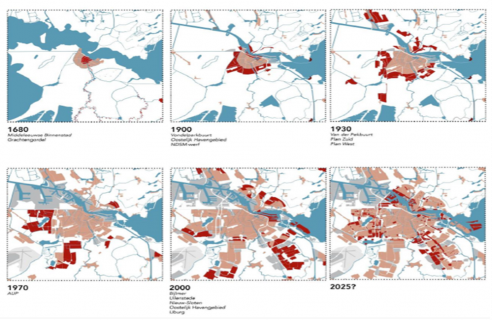This article is part of the series 25 building blocks to create better streets, neighbourhoods, and cities. Read whether Increasing density of cities complies with the quality of the urban environment.
There is widespread agreement to use the available space more thoughtful than during the last decades. In the Nationale Omgevingsvisie (NOVI), the Dutch government has unambiguously expressed its preference for housing locations within existing built-up areas or in the vicinity of stations.
The need for density
Frequently, references are made to ‘urban sprawl' in the USA to illustrate the disadvantages of low density. However, but The Netherlands is also familiar with extensive growth of the urban area. The maps above show the growth of the Amsterdam area. Between 1900 and 2000, the population of Amsterdam grew from 317,000 to 727,000 inhabitants. Its surface from 560 to 11,500 hectares.
The spread of urban activities over an ever-increasing surface and the associated traffic movements have led to vast monotonous areas, car dependence, expansion of the road network, increasing congestion, impoverishment of social life, air pollution, emissions of greenhouse gases and decline of nature.
A summary of 300 OECD research projects shows that compactness results in more efficient use of facilities, but that there are also disadvantages in terms of health and well-being, usually as results of air pollution and traffic.
Advantages of density
Denser development is generally associated with the availability of amenities within walking distance, creating support for better public transport accessibility, and leading to more efficient use of utilities. Moreover - corrected for the composition of the population - CO2 emissions in urban areas are at least 30% lower than in the suburbs. An advantage that disappears in case of high-rises.
No necessity to expand building outside urban areas
According to many urban planners, there is no reason to divert to locations outside the existing built-up area. They claim that there is sufficient space in every city for new residential locations, for instance disused office buildings and factory locations. Many new homes can also come available through the division of oversized single-family homes and the renovation and raising of older (porch) homes.
These arguments only hold if at the same time the nuisance by densification is limited. For example, by reducing car useto prevent the roads from becoming even more crowded and the streets even more filled with parked cars. I don't see that happening yet.
Competing claims on urban land use
There is another important objection to further densification and that is the fact that other forms of land use also appeal to available land within the urban space. For example, the expansion of industry, trade, research etcetera. preferably in the vicinity of living areas to reduce the length of trips.
The most important claim on the available space is the need to expand the city’s greenery. Research into the development of 'green' in Amsterdam and Brussels since 2010 shows that the open space ratio (OSR) in both cities has decreased. In Amsterdam this was 3.68 km2 (4.7%) and in Brussels 9.17 km2 (11.9%). This is in line with a recent study by Arcadis, which shows that the four major cities in the Netherlands score very poorly on healthy outdoor space, greenery, air quality, noise nuisance, heat stress and safety.
Inner- and outer-urban development revisited
The report therefore concludes that extension of the use of urban space for housing must be weighed up against other claims for the use of space, such as urban greening, urban agriculture, and the maintenance and expansion of business activities. At the same time, the objections to ecologically responsive building activities outside the already urbanized areas must be reconsidered. Three-quarters of the agricultural land is used for intensive livestock farming, not exactly creating valuable nature. I will come back to it later.
In the 'Dossier leefbaar wonen' (in Dutch)' I wrote extensively about the subject of providing affordable housing. You can download this e-book using the link below:





